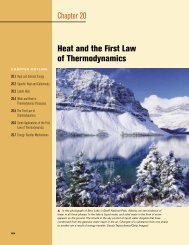15 • Oscillatory Motion - ECHSPhysics
15 • Oscillatory Motion - ECHSPhysics
15 • Oscillatory Motion - ECHSPhysics
Create successful ePaper yourself
Turn your PDF publications into a flip-book with our unique Google optimized e-Paper software.
What we now require is a mathematical solution to Equation <strong>15</strong>.5—that is, a function<br />
x(t) that satisfies this second-order differential equation. This is a mathematical<br />
representation of the position of the particle as a function of time. We seek a function<br />
x(t) whose second derivative is the same as the original function with a negative sign<br />
and multiplied by 2 . The trigonometric functions sine and cosine exhibit this behavior,<br />
so we can build a solution around one or both of these. The following cosine function<br />
is a solution to the differential equation:<br />
(<strong>15</strong>.6)<br />
where A, , and are constants. To see explicitly that this equation satisfies Equation<br />
<strong>15</strong>.5, note that<br />
dx<br />
dt<br />
A<br />
d<br />
dt<br />
d 2x dt 2 A<br />
x(t) A cos(t )<br />
cos(t ) A sin(t )<br />
d<br />
dt sin(t ) 2 A cos(t )<br />
(<strong>15</strong>.7)<br />
(<strong>15</strong>.8)<br />
Comparing Equations <strong>15</strong>.6 and <strong>15</strong>.8, we see that d 2 x/dt 2 2 x and Equation <strong>15</strong>.5 is<br />
satisfied.<br />
The parameters A, , and are constants of the motion. In order to give physical<br />
significance to these constants, it is convenient to form a graphical representation of<br />
the motion by plotting x as a function of t, as in Figure <strong>15</strong>.2a. First, note that A, called<br />
the amplitude of the motion, is simply the maximum value of the position of the<br />
particle in either the positive or negative x direction. The constant is called the<br />
angular frequency, and has units of rad/s. 1 It is a measure of how rapidly the oscillations<br />
are occurring—the more oscillations per unit time, the higher is the value of .<br />
From Equation <strong>15</strong>.4, the angular frequency is<br />
√ k<br />
(<strong>15</strong>.9)<br />
The constant angle is called the phase constant (or initial phase angle) and,<br />
along with the amplitude A, is determined uniquely by the position and velocity of<br />
the particle at t 0. If the particle is at its maximum position x A at t 0, the<br />
phase constant is 0 and the graphical representation of the motion is shown in<br />
Figure <strong>15</strong>.2b. The quantity (t ) is called the phase of the motion. Note that<br />
the function x(t) is periodic and its value is the same each time t increases by 2<br />
radians.<br />
Equations <strong>15</strong>.1, <strong>15</strong>.5, and <strong>15</strong>.6 form the basis of the mathematical representation<br />
of simple harmonic motion. If we are analyzing a situation and find that the force<br />
on a particle is of the mathematical form of Equation <strong>15</strong>.1, we know that the motion<br />
will be that of a simple harmonic oscillator and that the position of the particle is<br />
described by Equation <strong>15</strong>.6. If we analyze a system and find that it is described by a<br />
differential equation of the form of Equation <strong>15</strong>.5, the motion will be that of a simple<br />
harmonic oscillator. If we analyze a situation and find that the position of a<br />
particle is described by Equation <strong>15</strong>.6, we know the particle is undergoing simple<br />
harmonic motion.<br />
1 We have seen many examples in earlier chapters in which we evaluate a trigonometric function of<br />
an angle. The argument of a trigonometric function, such as sine or cosine, must be a pure number.<br />
The radian is a pure number because it is a ratio of lengths. Angles in degrees are pure numbers simply<br />
because the degree is a completely artificial “unit”—it is not related to measurements of lengths. The<br />
notion of requiring a pure number for a trigonometric function is important in Equation <strong>15</strong>.6, where<br />
the angle is expressed in terms of other measurements. Thus, must be expressed in rad/s (and not,<br />
for example, in revolutions per second) if t is expressed in seconds. Furthermore, other types of functions<br />
such as logarithms and exponential functions require arguments that are pure numbers.<br />
m<br />
SECTION <strong>15</strong>.2 <strong>•</strong> Mathematical Representation of Simple Harmonic <strong>Motion</strong> 455<br />
Position versus time for an<br />
object in simple harmonic<br />
motion<br />
▲ PITFALL PREVENTION<br />
<strong>15</strong>.3 Where’s the Triangle?<br />
Equation <strong>15</strong>.6 includes a trigonometric<br />
function, a mathematical<br />
function that can be used whether<br />
it refers to a triangle or not. In<br />
this case, the cosine function<br />
happens to have the correct behavior<br />
for representing the position<br />
of a particle in simple harmonic<br />
motion.<br />
A<br />
–A<br />
A<br />
–A<br />
x<br />
x<br />
(a)<br />
(b)<br />
Active Figure <strong>15</strong>.2 (a) An x -vs.-t<br />
graph for an object undergoing<br />
simple harmonic motion. The<br />
amplitude of the motion is A, the<br />
period (page 456) is T, and the<br />
phase constant is . (b) The x -vs.-t<br />
graph in the special case in which<br />
x A at t 0 and hence 0.<br />
At the Active Figures link<br />
at http://www.pse6.com, you<br />
can adjust the graphical representation<br />
and see the resulting<br />
simple harmonic motion of the<br />
block in Figure <strong>15</strong>.1.<br />
T<br />
t<br />
t



